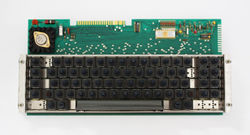IBM 3275/3277 Display Station Keyboard
 | |
| Manufacturer | IBM |
|---|---|
| Keyswitches |
Micro Switch SW Series IBM beam spring |
| Keycaps | Spherical double-shot |
| Weight | 3674 g |
| Years of production | 1971[1]–1979 |
The IBM 3275 and 3277 Display Station Keyboards were a family of terminal keyboards that spanned two types of key-switches (Micro Switch SW and IBM beam spring), two keycap finishes (smooth for World Trade usage or textured otherwise), two physical layouts (66-key and 78-key), and three functional layouts (1052-7 style operator console, [data] typewriter (DA) and data entry (DE)) along with various minor optional features.
Contents
Overview
The IBM 3275 and 3277 Display Stations were the original terminals for the IBM 3270 Information Display System unveiled on May 6, 1971 by the IBM Data Processing Division[1]. They were the beginning of the large IBM 3270 family of coaxial connecting terminals that remained relevant in the decades since their introduction. Upon introduction, the IBM 3270 family consisted of the following components:
- IBM 3271 Control Unit; Models 1,2, 11 and 12
- IBM 3272 Control Unit; Models 1,2
- IBM 3275 Display Station; Models 1,2, 11 and 12
- IBM 3277 Display Station; Models 1,2
- IBM 3284 Printer; Models 1, 2 and 3
- IBM 3286 Printer; Models 1 and 2
- IBM 3288 Line Printer; Model 2
The 3275 and 3277 differed by how they connected to a host computer such as an IBM System/360 or System/370 CPU - 3275 would attach to a CPU via an IBM 2701 Data Adapter Unit, IBM 2703 Transmission Control or an Integrated Communications Adapter, whereas 3277 would attach to an aforementioned 3271 or 3272 (which then subsequently attached to a CPU)[2]. Despite this, their keyboards are interchangeable and generally share part numbers, thus lacking a per-system distinction.
Layouts
IBM 327X keyboards were available in three functional layouts across two physical layouts:
- 66-key Data Entry Keyboard
- 66-key Typewriter Keyboard
- 78-key Typewriter Keyboard
- 78-key Operator Console Keyboard
Data Entry
The Data Entry keyboard was only available as a 66-key keyboard and was designed to resemble the layout of an IBM Card Punch keyboard with EBCDIC encoding. It had three PAx (program access) keys and five PFx (program function) keys. Data Entry keyboards are optimised for applications such as Source File Updating and Online Key Entry. Data Entry keyboards can be easily recognised by the "Field Mark" and "DUP" keys in their top rows and the various black-coloured keys surrounding the letter keys.
Typewriter
The Typewriter keyboard was available in either 66-key or 78-key form and either ASCII or EBCDIC style key legends. The 66-key version had two PAx keys but no PFx keys, however, the 78-key version had twelve PAxx keys. IBM referred to these as "Typewriter Keyboard" and "Typewriter Keyboard w/ 12 Program Function Keys" respectively.
Operator Console
The Operator Console keyboard was only available as a 78-key keyboard and was designed to resemble the layout of an IBM 1052 Model 7 (1052-7) Printer-Keyboard. It had a single PAx (PA1) key and twelve PFxx keys.
Versions
There are two technical variants of the IBM 3275/3277 keyboard assembly; the original first-generation dual magnet Micro Switch SW Series switches assembly and the later IBM capacitive beam spring switches assembly. IBM referred to these as "Type A" and "Type B" keyboards respectively (once Type B was available) regardless of other considerations such as physical or functional layout.
Type A
Type A keyboards were the original design that first shipped upon the 3275's and 3277's introduction in 1971. These keyboards were assembled by IBM, with keyboard assembly parts provided by Honeywell International. They used first-generation Micro Switch SW hall effect switches.
Type B
Type B keyboards were the revised keyboards that for a time were shipped alongside Type A. These keyboards have assemblies made by IBM themselves, sporting their own capacitive beam spring switches.
Gallery
Type A 66-key Typewriter
Type B 66-key Data Entry
Type B 66-key Typewriter
Type B 78-key Typewriter
References
- ↑ 1.0 1.1 IBM — DPD chronology (Page 4) (Wayback Machine) Archived 2020-01-03.
- ↑ IBM — GA27-2739-1: An Introduction to the IBM 3270 Information System (bitsavers)
External links
- IBM — IBM 3277 Display Station Models 1 and 2 Troubleshooting Guide PDF (bitsavers, Internet Archive)
- Columbia University Computing History — The IBM 3270
- Deskthority — IBM 3277 keyboard with Micro Switch key switches
- Deskthority — IBM 3277 typewriter keyboard / Micro Switch SW Series



























